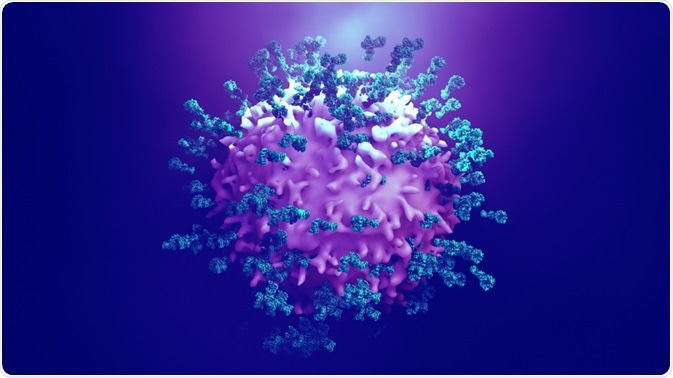Cancer immunotherapy is a key area of therapy for cancer patients. It is particularly important as an area of novel drug development, with the primary type of drugs in immunotherapy being monoclonal antibodies (mAbs).

Image Credit: Design_Cells/Shutterstock.com
Therapeutic mAbs can exploit the fact the cancer cells often present cell-surface macromolecules that are either not found in the same form on non-cancer human cells or are overexpressed/ overproduced in cancer cells.
Monoclonal antibodies that bind cancer cells or immune cells can help promote the recruitment of immune cells to a tumor site, activate parts of the immune response, or inhibit immune suppression by cancer cells, among others.
Types of monoclonal antibodies used in cancer therapy
There are two main types of mAb used in cancer immunotherapy. One is a traditional mAb, which binds a cancer cell with two Fab regions and activates an immune response by an Fc region. The others are mAbs conjugated to a chemotherapeutic drug or radioactive particles, acting to directly target chemotherapy or radiotherapy specifically to cancer cells.
Necitumumab is a recombinant mAb that targets the epidermal growth factor receptor (EGFR). This receptor is overexpressed in many types of cancer, and the binding of different types of growth factors to the receptor is a major cause of uncontrolled cell growth in these cancers.
The binding of Necitumumab to EGFR inhibits this activity, contributing to a reduced growth rate in some cancers. It is approved by the FDA and has been useful in treating metastatic squamous non-small-cell lung carcinoma.
Gemtuzumab ozogamicin is an example of a conjugated mAb. It binds Siglec-3, which is found mostly on myeloid immune cells and is involved in the inhibition of phagocytosis within the cell.
This is used in acute myelogenous leukemia where it delivers ozogamicin to target cells. This drug is a chemotherapeutic of the class of calicheamicin which breaks apart the double helix of DNA, causing cell death.
Radioactive conjugated mAbs include Ibritumomab tiuxetan which is used in B cell non-Hodgkin’s lymphoma. It binds CD20 on target cells, delivering yttrium-90 radioactive particles to affected B cells, leading to radiotherapy-mediated cell death.
Resistance against mAbs and combination therapy
While there have been promising results from many studies, many mAbs have elicited relatively poor responses in patients, and resistance to different drugs has developed.
This resistance may be an intrinsic part of the cell architecture, this is seen when a mAb is ineffective in a patient from the start of treatment. Alternatively, resistance may be acquired throughout a treatment, where sensitivity to treatment reduces over the treatment period.
A good example of this acquired resistance is against rituximab. This is a mAb used in some lymphomas that binds CD20 on B cells, triggering cell death. It was one of the first mAbs approved for use as a cancer treatment in 1997. Over a treatment period, cells may stop expressing CD20 on the cell surface, removing the binding target of the drug.
Another resistance mechanism can be found in HER2-positive breast cancers where the innate heterogeneity of HER2 leads to the promotion of an isoform that a drug such as trastuzumab cannot bind to, allowing cancer to evade treatment.
Combination therapy can help to overcome any resistance and increase the chance of a successful outcome. While this can take the form of conjugated mAbs as described above, this doesn’t have to be the case and a combination of separate therapies can be effective.
A phase III clinical trial in HER2 positive breast cancer compared a standard chemotherapy regimen alone to combination therapy with trastuzumab. This resulted in a median time to progression of 3.0 months in the control group, compared to 6.9 months in the trastuzumab group.
As described in the previous section conjugated mAbs can also be a useful tool in combination therapy to deliver radioactive or cytotoxic drugs to a target site.
Another option is the combination with protein kinase inhibitors (PKI). These inhibitors have been highly effective since their introduction in 2001 and have been key to allowing the management of some previously fatal cancers.
PKIs bind different protein kinases within the cell, inhibiting their action and producing a variety of effects depending on the kinase targeted. But as with mAbs resistance has become a problem due to different mechanisms, including point mutations around their binding site on the kinase.
Combining a mAb and PKI which target the same molecule has been shown to have a synergistic effect and improve outcomes. This involves using a mAb which specifically binds the target molecule and PKI which targets a downstream protein kinase.
For example, a phase II clinical trial with erlotinib and bevacizumab, which both target EGFR, in non-small-cell lung cancer was shown to be effective.
Continued development of new mAbs, alongside the exploration of different combination therapies, will contribute to ongoing improvements in cancer survival. This will also help future therapies to overcome novel anti-mAb resistance as it develops.
Sources:
- Kimiz-Gebologlu, I., Gulce-Iz, S. and Biray-Avci, C. (2018) ‘Monoclonal antibodies in cancer immunotherapy’, Molecular Biology Reports. Springer Netherlands, pp. 2935–2940. doi: 10.1007/s11033-018-4427-x.
- Marrocco, I., Romaniello, D. and Yarden, Y. (2019) ‘Cancer immunotherapy: The dawn of antibody cocktails’, in Methods in Molecular Biology. Humana Press Inc., pp. 11–51. doi: 10.1007/978-1-4939-8958-4_2.
- Walker, S. et al. (1992) ‘Cleavage behavior of calicheamicin γ1 and calicheamicin T’, Proceedings of the National Academy of Sciences of the United States of America. National Academy of Sciences, 89(10), pp. 4608–4612. doi: 10.1073/pnas.89.10.4608.
Further Reading
Last Updated: Oct 27, 2021